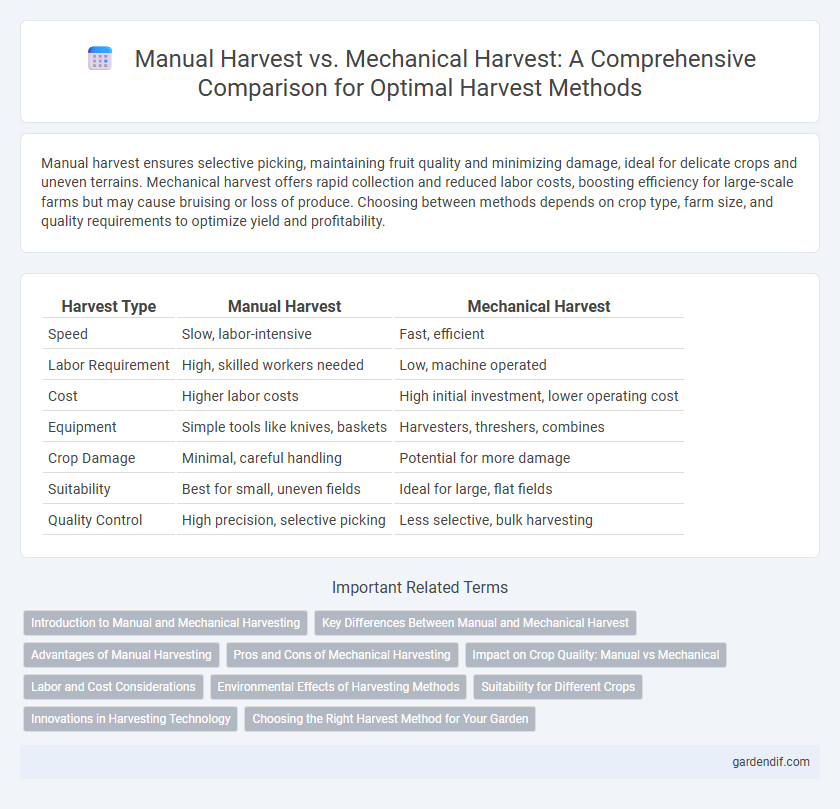
Manual Harvest vs Mechanical Harvest Illustration
Manual harvest ensures selective picking, maintaining fruit quality and minimizing damage, ideal for delicate crops and uneven terrains. Mechanical harvest offers rapid collection and reduced labor costs, boosting efficiency for large-scale farms but may cause bruising or loss of produce. Choosing between methods depends on crop type, farm size, and quality requirements to optimize yield and profitability.
Table of Comparison
| Harvest Type | Manual Harvest | Mechanical Harvest |
|---|---|---|
| Speed | Slow, labor-intensive | Fast, efficient |
| Labor Requirement | High, skilled workers needed | Low, machine operated |
| Cost | Higher labor costs | High initial investment, lower operating cost |
| Equipment | Simple tools like knives, baskets | Harvesters, threshers, combines |
| Crop Damage | Minimal, careful handling | Potential for more damage |
| Suitability | Best for small, uneven fields | Ideal for large, flat fields |
| Quality Control | High precision, selective picking | Less selective, bulk harvesting |
Introduction to Manual and Mechanical Harvesting
Manual harvesting involves the use of human labor to pick crops by hand, offering precise selection and minimal damage to fruits and plants, which is essential for delicate produce such as grapes and coffee cherries. Mechanical harvesting employs machinery like combine harvesters or grape harvesters, significantly increasing efficiency and reducing labor costs, especially in large-scale operations for crops like wheat, corn, and apples. The choice between manual and mechanical harvesting depends on factors such as crop type, field size, labor availability, and cost-effectiveness.
Key Differences Between Manual and Mechanical Harvest
Manual harvest involves labor-intensive handpicking, allowing for selective fruit or crop gathering with minimal damage, ideal for delicate produce but slower and costlier. Mechanical harvest uses machinery to quickly collect large quantities, significantly increasing efficiency and reducing labor costs, yet potentially causing more crop bruising and less precision. Key differences center on speed, cost, crop quality, and suitability to specific crops or terrain.
Advantages of Manual Harvesting
Manual harvesting offers precise selection and minimal crop damage, ensuring higher quality produce compared to mechanical methods. It allows for careful handling of delicate fruits and vegetables, reducing bruising and spoilage during collection. Skilled laborers can adapt to varying field conditions and identify ripe crops, resulting in improved yield and market value.
Pros and Cons of Mechanical Harvesting
Mechanical harvesting increases efficiency by rapidly gathering crops, reducing labor costs and time compared to manual methods. It may cause more crop damage due to the machinery's rough handling, which can affect quality and yield. Initial investment and maintenance costs for mechanical harvesters are high, but they provide long-term savings and consistency in large-scale farming operations.
Impact on Crop Quality: Manual vs Mechanical
Manual harvest preserves crop quality by minimizing damage to delicate fruits and vegetables, ensuring higher market value due to better appearance and freshness. Mechanical harvesters increase yield efficiency but often cause bruising, cuts, or contamination, which can reduce shelf life and lower overall quality. Choosing between manual and mechanical methods depends on the crop type and desired balance between quality and productivity.
Labor and Cost Considerations
Manual harvest requires significant labor input, often involving seasonal workers and higher wages, which can increase overall production costs. Mechanical harvest reduces labor dependency, leading to faster crop collection and lower long-term operational expenses despite high initial investment in equipment. Cost considerations must balance labor availability, machinery maintenance, and crop type to determine the most efficient harvesting method.
Environmental Effects of Harvesting Methods
Manual harvest techniques minimize soil compaction and reduce damage to surrounding vegetation, preserving ecosystem balance and promoting biodiversity. Mechanical harvesters, while increasing efficiency, often lead to higher carbon emissions due to fuel consumption and contribute to soil degradation through repeated machinery passes. Selecting sustainable harvesting methods is crucial for maintaining soil health and reducing the environmental footprint of agricultural practices.
Suitability for Different Crops
Manual harvest is ideal for delicate crops such as grapes, coffee, and specialty fruits, ensuring minimal damage and selective picking based on ripeness. Mechanical harvest suits robust crops like wheat, corn, and cotton, enabling faster collection over large fields but may cause damage to sensitive produce. Crop type, terrain, and labor availability play crucial roles in determining the suitability of manual versus mechanical harvesting methods.
Innovations in Harvesting Technology
Innovations in harvesting technology have revolutionized the efficiency and precision of both manual and mechanical harvest methods. Advanced sensors, GPS-guided machinery, and AI-powered automation optimize crop yield assessments and reduce labor costs in mechanical harvesting. Manual harvesting benefits from ergonomic tools and portable digital devices that enhance worker productivity and ensure selective picking for high-quality produce.
Choosing the Right Harvest Method for Your Garden
Selecting the appropriate harvest method depends on garden size, crop type, and labor availability. Manual harvesting offers precise control and minimizes damage to delicate fruits, making it ideal for small-scale or specialty crops. Mechanical harvesting increases efficiency and reduces labor costs in large-scale operations but may cause more damage to produce if not properly managed.
Manual Harvest vs Mechanical Harvest Infographic

 gardendif.com
gardendif.com